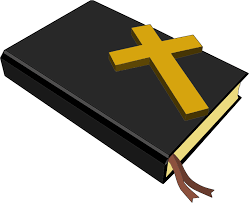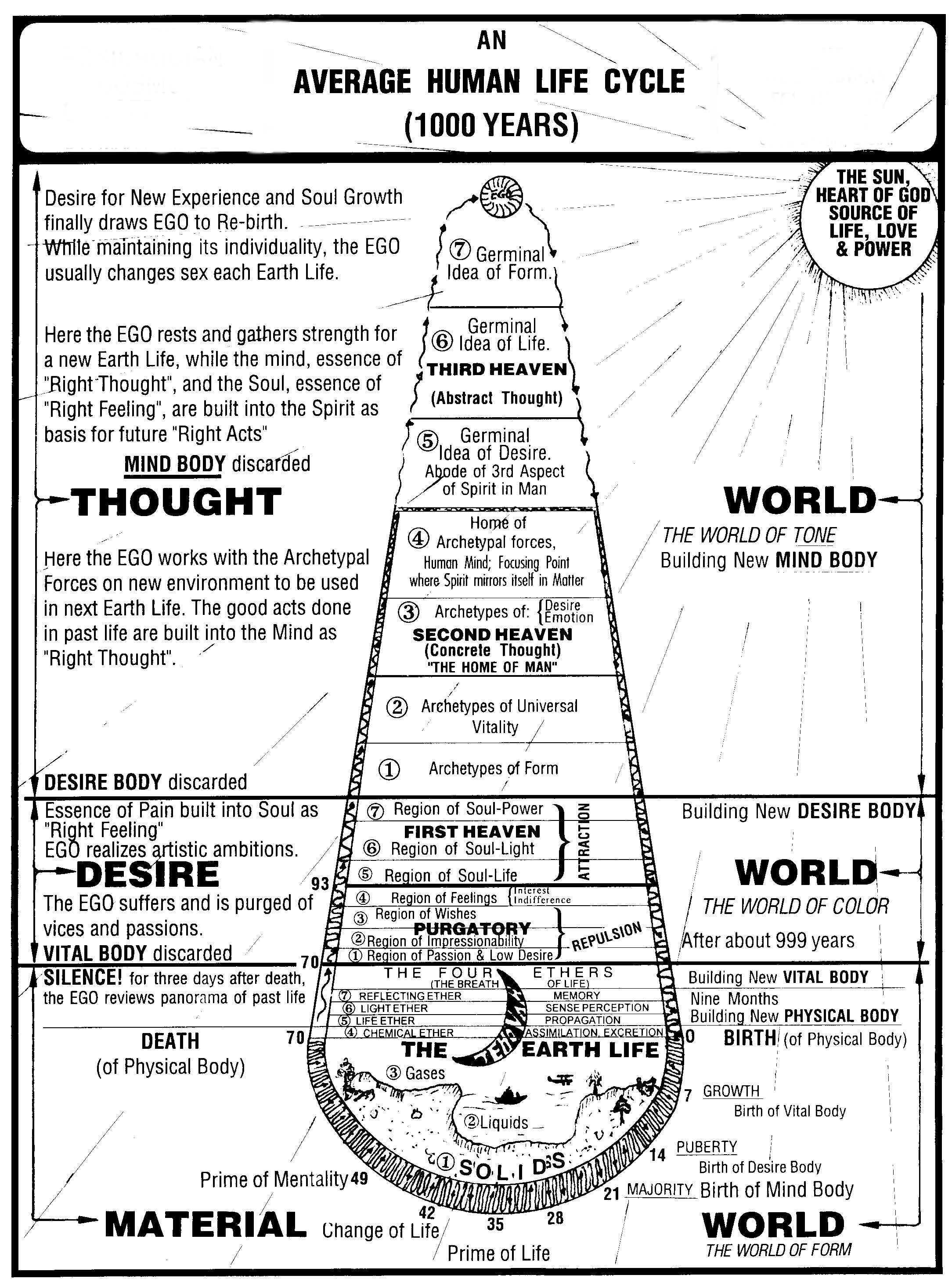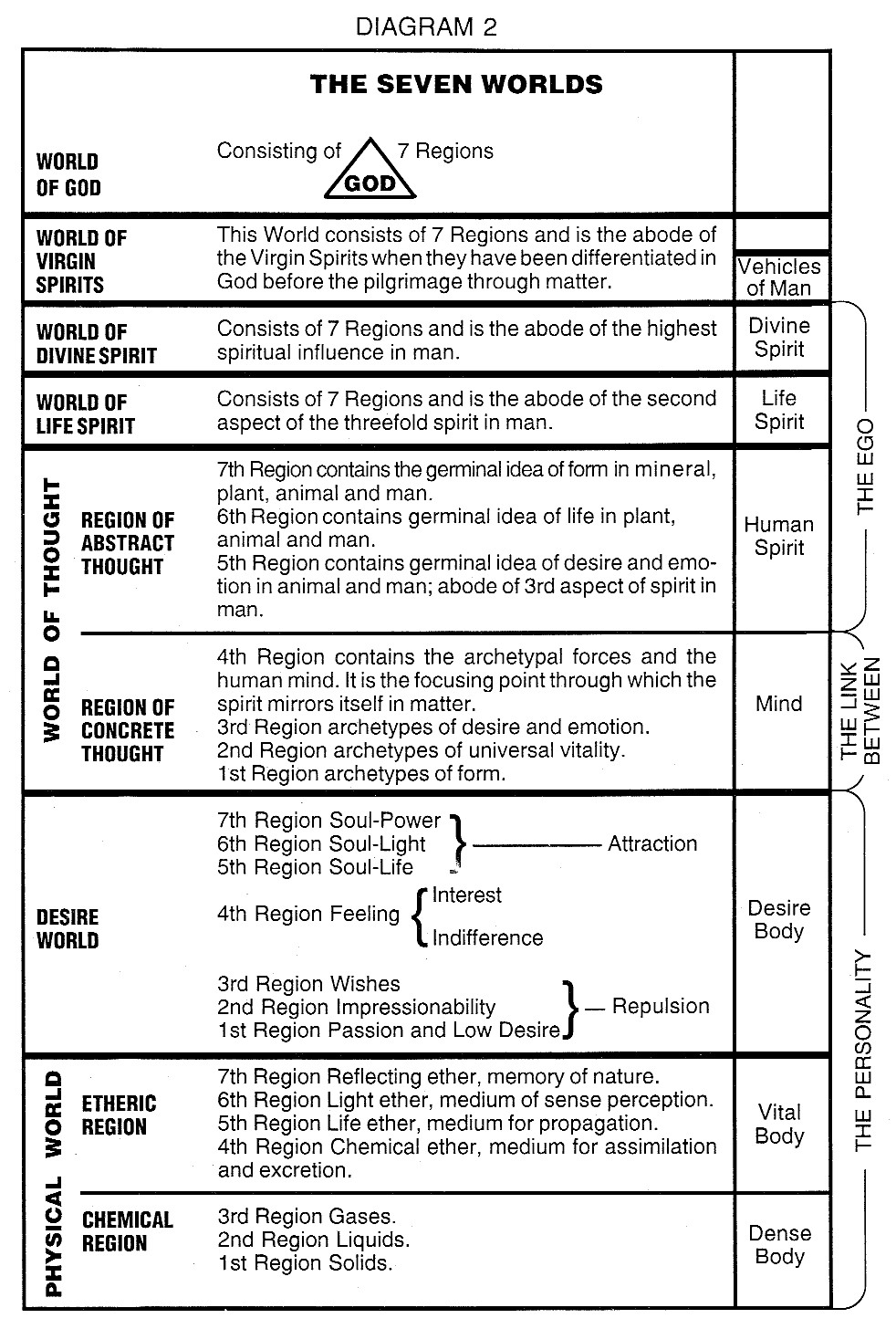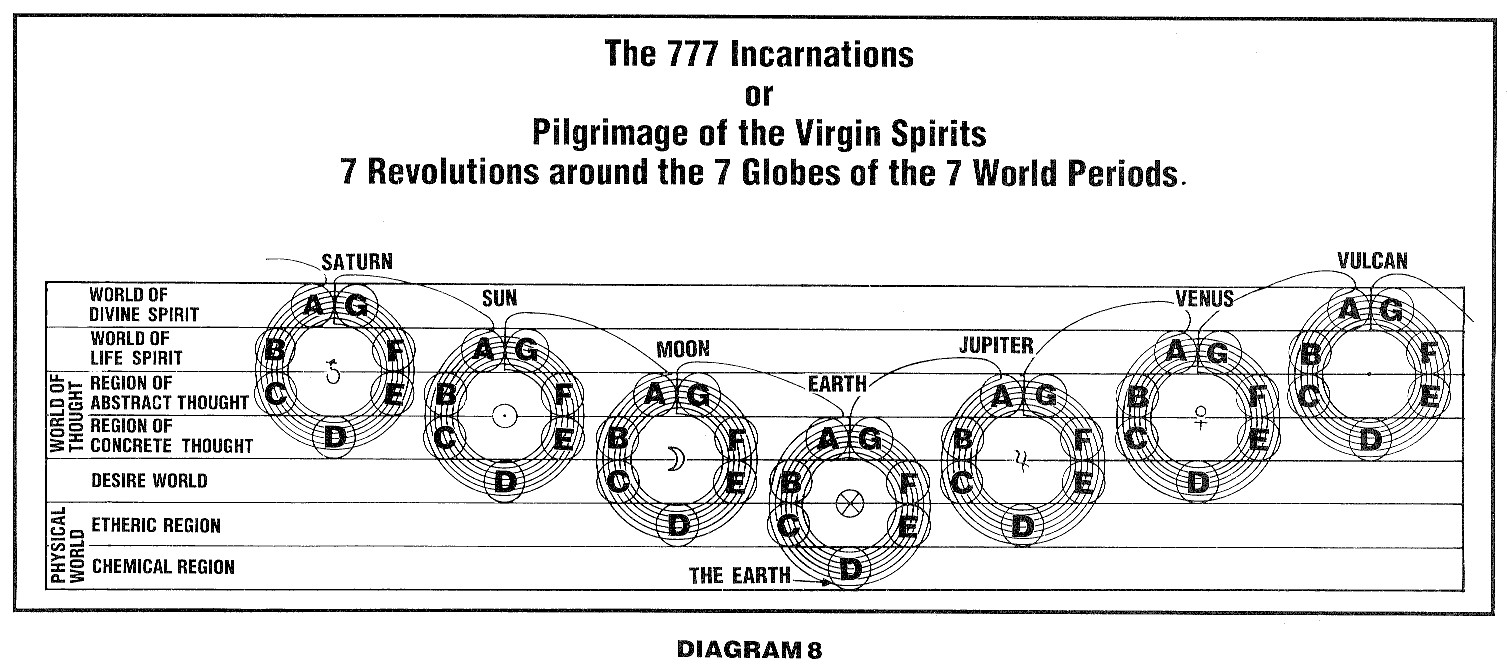
| rosanista.com | ||
| Simplified Scientific Christianity |

Initiation may be described as a death-process, for in it the candidate undergoes experiences that parallel those of a departed spirit, with the exception that the silver cord, which links the spirit to the physical body, is not broken as it is in death. Before the coming of the Christ Initiation was restricted to priestly and royal houses which, by generations of selective breeding, had produced bodies with requisite qualities for safety while undergoing this very dangerous Rite. The spirit might leave its earthly house and be unable to return to it, the result being death. Or, if the trials to which it was subjected in the lower regions of the Soul World were too severe for it, the spirit might rush back to its body with a force born of terror and dangerous to the heart. The aftermath of this might be invalidism from rupturing the etheric sheath of the brain and nerves, thus leading to nervous and mental disabilities, or death. The danger was very great, so the secrecy with which the priesthood surrounded these matters was not wholly for the purpose of a selfish monopoly of knowledge. Originally, it was done in the interest of the people themselves, to protect them.
To the masses the Book of the Dead was a guide to right conduct, the practice of its tenets leading to enhanced bliss and wisdom in the life to come. By means of daily chants the spirit was slowly and gently awakened; but for any intensive psychic and spiritual unfoldment, special disciplines and studies were necessary — and these only under the close personal supervision of an Initiate Teacher. Members of the royal family were all students of initiatory teachings, since such knowledge was considered indispensable for governing the nation and furthering its culture.
The initiatory aspect of Rituals found in the Book of the Dead are now applicable to the masses of humanity everywhere. In studying its texts it is essential to keep in mind that they are for the individual and that one of the Elder Brothers stands at the neophyte's right band to help, to instruct and to protect him at all times.
The book contains approximately one hundred and forty chapters, each chapter dealing with some phase of the afterlife or of its initiatory equivalent. The most complete of these manuscripts is the papyrus of Ani, profusely illustrated in colors still as bright and vivid as when the parchment was painted many thousands of years ago. In the first of the illustrations the mummified body (candidate for Initiation) is made ready for the tomb. Later drawings depict various underworld experiences culminating in the judgment Hall of Osiris with the weighing of the heart. These tests prepare the way for the Rite of Mastership wherein an emancipated candidate "walks amid the stars."
True Initiation has never been a matter of mere ceremonialism, but Egyptians knew that the soul is sensitized through beauty. It was from this point of view that ceremonials as an art form played a very important part in their initiatory work. Initiation is not primarily concerned with flowing robes and lighted candles. It is primarily concerned with living a good and holy life, for evil thinking and evil living belong to illusion, and the spirit desiring reality will not allow itself to be entangled in the illusory. Plato rationalized this Egyptian teaching for the Greeks in his famous allegory of the shadows cast on the wall of a cave in which men sat in darkness, not knowing that they had only to turn about, face the light, and follow it to the Sun in order to be liberated from their phantom world.
In the Egyptian Mysteries the candidate or worthy one was admitted into the exalted Rites when "There is not in all the world a sinful one, or a suffering one, or a weeping one, through any deed of mine. I never made any man work beyond his strength and have never failed to give bread to the hungry and water to the thirsty."
The many references to animals symbolize traits of character in the candidate himself, the chief embodiment of which is the Dweller on the Threshold in its many aspects, as the lower guardian is subject to many changes as the person's character develops. Not all symbols from the animal kingdom were evil. Good qualities were also symbolized by forms drawn from lower orders. Birds usually represented gratitude, peace, aspiration. The swallow, sacred to Isis, was the inspiration for The Song of Changing into a Swallow: "I am a swallow! I am a swallow! I now pass to the Island of Flame. I am purified. I have done away with wickedness. I have put away utterly my offenses. I have made myself to be like a god. Hail, O ye doorkeepers, I have completed my journey. I am like you. I have come forth by day. I have gained the mastery. I know the hidden road and the Gates of Sekhet."
in the Book of the Dead the hawk is sacred to the Sun and not a symbol of evil, as evidenced by The Song of Changing into a Hawk of God: "Osiris Ani saith: My wings are like unto the mother-of-emerald of the South. My heart has been brought into me from the mountains of the East. Ra hath entered in and I have taken my seat among the gods." Wings symbolized the jewel-like colors in the rushing streams of force of a purified aura. "The grain god (Nepra) hath given unto me food for my throat and I am master over myself and the attributes of my head."
During the three and one-half days of the Egyptian Rite of Mastership, the body of the candidate lay within a tomb while he himself, in his celestial body, underwent varied underworld or purgatorial experiences. At the hour of sunrise on the third day, the spirit returned to its body in full consciousness of what had occurred, convinced of the continuity of life beyond the grave. He was then hailed as "the New Born" or "the Divine Walker Amid the Stars." "The glory of Osiris is upon me. My feet are set forever in the eternal places. I walk among the stars."
Christians who find it hard to use the name of Osiris, even when understanding that the Christ is meant, should bear in mind that the word Osiris, like the word Christos, is not a name at all. When Egyptians said Osiris it was the same as when Christians say "Our Lord." Hebrews use the title "Adoni" as the Sacred Name of God. The "secret Name" is never mentioned in any ancient Scriptures. A term with the same meaning as "Our Lord" has invariably been used to avoid mention of a specified sacred name with its magical potencies. An inscription found in the Temple of Isis at Philae states "This is the form of him whom we may not name (Osiris) of the Mysteries, who sprang from the returning waters."
Texts may only hint of powers conferred upon a successful candidate but it is understood that he comes into knowledge of his own true nature as a Son of God, one with the Father. To quote from The Deceased Becomes Divine: "Seer of a Million Years is my name. I am the Lord of Eternity. I am He who cannot be known." Again, in Songs of Becoming the Light of God and of Awakening (the second Death): "I rise up, but he who cometh after me hath fallen. Truth is in my body. I have come to light in the darkness. I have made an end to the darkness which hath become light indeed. O my Father Osiris. Thou hast done for me what Thy Father Ra did for thee. Let me abide upon the earth permanently. Set comes with head bent low upon the ground. The deceased shall never cease from the earth, but like his divine namesake, Ra, he shall be there for a million billions of years."
The candidate who had become an Initiate was found worthy to enter into the presence of Osiris and to be numbered among the followers of Horus forever. "Companions of Horus" are mentioned in earliest Egyptian texts as "sky people," said to refer to inhabitants of the mighty constellation Orion. Sirius, the great star following this constellation and culminating at midnight of the Winter Solstice, was called the Star of Isis. Knowledge concerning celestial intercommunion between high Initiates upon earth and Beings far off in stellar space was taught by Atlantean priests and passed on to their neophytes and disciples in the early days of colonization in Egypt. The wise knew no fear of death; they referred to it poetically as "flight to the stars."
In later Egyptian literature occur many passages comparable to the best ones in our Christian Bible. Apostrophes to the glory of night and the splendor of stars are reminiscent of the Psalms of David. Verses such as the following show that Egypt had already come to an understanding of the Oneness of God before the advent of the Christ:
Hermes the Thrice-Great had done well his work in Egypt. No ancient land was better prepared for the Divine Coming. To this land of Egypt the heart of the West must ever turn in reverence and love. Yet it was, even at its, highest, merely the preparing ground for the One Altogether Lovely. He came not as a stranger unto the Egyptians, for they knew Him from of old. He came, their jewel-winged Phoenix, and Egypt was the altar whereon He built His nest of frankincense and myrrh. There He plumaged Himself anew in Christianity. And this Bright Bird who came out of the East will one day fly again to the East, from His pinions showering light over all nations.
— Corinne Heline

|

|

|
|
|
Contemporary Mystic Christianity |
|
|
This web page has been edited and/or excerpted from reference material, has been modified from its original version, and is in conformance with the web host's Members Terms & Conditions. This website is offered to the public by students of The Rosicrucian Teachings, and has no official affiliation with any organization. | Mobile Version | |
|